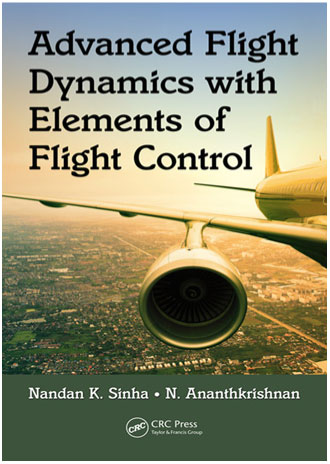
This is a flight dynamics book with a strong focus on nonlinear dynamics and control aimed at advanced undergraduate and postgraduate students who want to further specialise in flight dynamics. The authors have structured the book such that it can be a very valuable resource for the readers who want to transfer from linear to nonlinear flight dynamics. This book sits well as a bridge between literature that focus on linear analysis, for example Flight Dynamic Principles by M. V. Cook (Elsevier Butteworth-Heinemann. 2013 – Third edition), on the one hand, and others such as Flight Dynamics by R. Stengel (Princeton University Press. 2004) that have a very broad scope.
Like many books focusing on this topic, the authors begin by informing the reader of aerodynamic modelling methods in Chapter 2. Here they do not just present the mathematical model as a simple Taylor series expansion but emphasise the physical meaning of the terms – divided into static and dynamic derivatives as well as derivatives that capture interactions between the various aircraft components and lead to various system lags (e.g. downwash). The case study here is the F-18 High Alpha Research Vehicle (HARV) model that can be found in numerous research publications and is effectively open source. The sample simulations and corresponding discussions are very helpful.
At this point, the reader should note that this book does not focus on modelling and simulation. Topics such as the development of complex simulation models aimed towards implementation in flight simulators or for handling qualities analysis are not covered.
The authors introduce the reader to continuation methods and bifurcation analysis in Chapter 3. This chapter contains a discussion of nonlinear dynamic systems theory covering the key technical aspects and provides sufficient discussion with aerospace applications. The students/readers benefit from the use of simple but very insightful examples such as the phugoid reduced-order nonlinear model allowing the reader to relate continuation methods and bifurcation diagrams to flight dynamics. These first few chapters lay the foundations for the in-depth discussions later in the book.
Chapters 4–6 cover the primary areas of flight dynamics split in a very traditional manner presenting longitudinal, lateral-directional flight dynamics and control. A strong understanding of Chapter 3 is critical to fully grasp the discussions in these chapters. To limit the scope of the book, the authors have not presented significant details on the modelling of atmospheric disturbances (such as gust or continuous turbulence). They rightly point the reader towards books such as Dynamics of Atmospheric Flight by B. Etkin (John Wiley. 1972) for more detailed explanation of atmospheric disturbance modelling for flight mechanics purposes. Moreover, those specifically interested in turbulence and gust models can look into the work by Frederic Hoblit.
Chapter 5 is dedicated to longitudinal control. A good overview of autopilots seen on-board today’s aircraft is followed by introductions to gain scheduling techniques and flight control synthesis using the method of dynamic inversion. However, given the scope of the book, the authors do not provide a detailed recipe for applying these methods. For this the reader needs to get to the case study in Chapter 8. Furthermore, in Chapter 7, the authors provide a much-needed presentation on longitudinal and lateral coupling, and given the book’s focus on nonlinear flight dynamics, these chapters allow the discussion of methods that can be very powerful analytical tools for issues such as wing rock, loss of control and other upset scenarios. Chapter 8 concludes the book by bringing together the methods and tools from earlier chapters by presenting the reader with an in-depth case study focusing on a thruster-controlled spacecraft.
The book also covers level flight along with other steady flight conditions very well in the context of applying bifurcation analysis to nonlinear aircraft models and provides a comparison with traditional methods. The authors have included MATLAB® codes and Simulink® models, which are very good for readers to apply the theory. However, there are too few of these examples. This could have been addressed via more exhaustive reference lists at the end of each chapter. To a certain degree, the structure of the book is constrained by the various technical domains within flight dynamics. However, the authors have done well to gradually introduce the topics of continuation methods and bifurcation analysis such that students and researchers entering the field of flight dynamics are encouraged to pursue further study. Homework exercises that are distributed through the chapters along with problems at the end of the chapters make this book very suited to teaching. I hope that the authors have a solutions booklet to go along with this book. These encourage students/readers to think beyond the conventional fixed-wing aircraft configurations.
There are numerous exceptional books today on the topic of flight dynamics, and each covers the various disciplines within flight dynamics exhaustively. However, here the authors have made a strong contribution to an area of flight dynamics that has tended to remain on the pages of research articles and conference proceedings.




